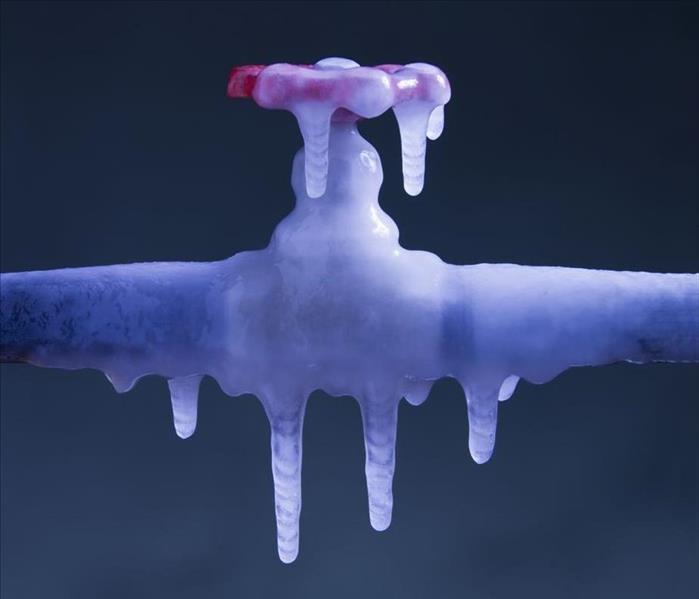How to Thaw a Frozen Pipe
11/14/2017 (Permalink)
 A frozen pipe can exert pressure at over 2,000 Lbs/ square inch, enough pressure to rupture almost any pipe filled with water.
A frozen pipe can exert pressure at over 2,000 Lbs/ square inch, enough pressure to rupture almost any pipe filled with water.
Frozen water pipes are a serious risk during very cold winter weather. When water freezes in a pipe it expands and can exert pressure at over 2,000 pounds per square inch. This pressure is enough to rupture almost any pipe filled with water, which provides no place for the ice to expand. A burst pipe can spill several hundred gallons of water per hour, and that equates to thousands of dollars of damage to your home. Pipes are most susceptible to freezing when they are located:
- in an outside wall
- in a cabinet under a sink (especially near an outside wall)
- in an unheated crawl space or basement
If your pipe is frozen but not yet ruptured, you must thaw it right away. There are a few thawing techniques to try, depending on where the frozen pipe is located.
Warning: Never use a blow torch or other open flame to thaw a pipe. This presents a serious fire hazard and can damage the pipe.
A frozen pipe that hasn't burst yet often reveals itself at a faucet: when you turn on the faucet and no water comes out or it has slowed to a trickle, there's probably a blockage of ice somewhere in the line. It's time take immediate action:
- Shut off the water to the faucet locally or at the home's main water shutoff valve.
- Open the faucet that is supplied by the frozen pipe; do this even if you don't know where the blockage is.
- Identify the frozen pipe and locate the blockage: Follow the pipe back from the faucet to where it runs through cold areas, such as an exterior wall or unheated crawl space. Look for areas on the pipe that have frost or ice; it may also be slightly bulged or fissured.
When you find that the frozen—but not yet burst—pipe is behind a wall or ceiling, you've got a challenge on your hands. You have three options for thawing the pipe:
- Turn up the heat in the house and wait.
- Cut out a section of the wall or ceiling to access the frozen section of pipe, then thaw the pipe as an exposed pipe (see next slide).
- Use an infrared lamp to help heat the wall section in front of where you believe the pipe is frozen. Infrared lamps are better than regular heat lamps because they pass through the air without heating it and will direct more energy to warming the wall and frozen pipe.
If the frozen pipe is exposed, you have several options for thawing it. Whichever remedy use use, heat the pipe from the faucet toward the frozen area. This allows water to flow out as the ice melts.
- Hair dryer: Usually the easiest and safest way to thaw a pipe. If the pipe is close to the wall, place a cookie sheet behind the pipe to help radiate heat onto the backside of the pipe.
- Heat lamp: You can use an infrared or incandescent heat lamp. As with a hair dryer, if the pipe is close to the wall, use a cookie sheet behind the pipe to help reflect heat onto the pipe.
- Portable heater: A small, powerful heater works great for warming pipes under a kitchen or vanity base cabinet. Direct the heater onto the frozen section of pipe. It will work like a hair dryer on steroids!
- Electric pipe heat tape: Heat tape is a ribbon-like wrap that contains electrical heating elements. You wrap it around the pipe you want to heat and plug it into the wall. The temperature of the tape is controlled with a thermostat. Heat tape can also be used to prevent pipes from freezing in critical areas; you can leave the heat tape on the pipe and plug it in only when needed.
There are a few things you can do to prevent the problem of freezing pipes from occurring again:
- Leave the faucet dripping slightly during the coldest time of the day or night.
- Open the cabinet doors to allow the heated air from the room to reach pipes inside the cabinet.
- Wrap the problem pipe with electrical heat tape.
- Insulate problem pipes with foam insulation wrap, especially those that run through unheated spaces. Note: Insulation merely slows the transfer of heat and will not prevent a pipe from freezing if the surrounding air is cold enough.
- Heat unheated areas with a permanent heater, just to keep the temperature above freezing, or about 40 degrees F. Warning: Do not use portable heaters, which should never be left running unattended.
- Remove garden hoses attached to outdoor faucets (hose bibs or sill cocks). If the faucet is not a frost-proof type, turn off the water to the faucet inside the house and drain the exterior section of the pipe and faucet.






 24/7 Emergency Service
24/7 Emergency Service